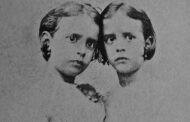The Portland Gothic House & Cuba Connection
Part II: Horatio Fox & the Spanish Colony of Cuba

By Marta Morse
Portland has an illustrious past. Before the American Revolution, ships were already carrying trade from the Caribbean and bringing wealth to the city. Horatio Fox and family, once residents of my home, the Portland Gothic House, played a role in this history in a variety of ways.
I began researching connections between the Fox and McLellan families at the Maine Historical Society‘s library. Sarah Jane Brown was a granddaughter of Abigail and Hugh McLellan. The Browns built the Portland Gothic House across the street. Why in this style? British architect, Henry Rowe advertised: “…can supply gentlemen in any style and taste, from the most elaborate Gothic…” And money was no object for J.J. Brown: Stock Exchange & Money Broker, 43 Exchange Street. My further study found the dwelling emerging as a connecting link to Cuba. In fact, by 1783 trade between the newly independent USA and Cuba already had history…
Horatio Fox Sails to Cuba

Charles Fox (1782-1845), Portland merchant, married Eunice (1784-1837) daughter of Hugh and Abigale McLellan (owner of Maines largest shipping fleet) in 1805 at the McLellan mansion. As their family grew 19-year-old son Horatio (1815-1902) was encouraged to enter a business trade based in Cuba.
He arrived in Trinidad de Cuba at about 1837. He likely sailed aboard one of his uncle’s ships carrying diverse types of lumber, including broken down timber staves to be formed into casks for the return voyage bringing sugar and molasses. Trinidad de Cuba already had streets paved from Portland ships’ ballast.
After ten years Horatio had established himself as a successful businessman and landholder. In 1846, he married Mercedes Yurubi, a Cuban born Spaniard.
There is little insight into life in Trinidad for this growing family. A brief view came through Horatio’s sister Anne. She arrived January 1865, during the height of sugar production in Trinidad’s Valley of the Sugar Mills… Valle de los Ingenios.
Fox Family Correspondence
While with the family, Anne’s letters share insight with distant Portland relatives, especially six little girls. She wrote about time spent in the nearby hills, cooling in streams “…if you could only come here and enjoy this beautiful climate would I know it would give you renewed strength as I know it is giving me…”
Mail was sporadic, dependent on cargo ship arrivals and departures. Anne replies to her sister, “… try to answer as they come but Sunday I received six by one mail and only that one day to answer in, for Horatio must have them to take down by six the next morning. …see by the New York papers milk men are charging fifteen cents a quart…”
An early morning drive in horse and buggy to the plantation where “it is the first day of grinding, a great day on an estate. We saw the whole operation from the cutting of the cane to the final finishing of the sugar except putting it in the barrels.
“Horatio is here for the day and night and when he returns to the city in the morning Mercedes will go too. She likes to go down once in a while to see about the house…” Reference is likely to the family home in Trinidad de Cuba. Horatio was kept busy in the sugar export business and his duties as American Council (from 1868 until leaving Cuba in 1878). Where the family was during time at the “estate” is unclear. Did he actually have a plantation or was he a member of the larger West India Trade?
Back Home, War Breaks Out
Carlito (1849) and Enrique (1850), oldest of the Fox boys, were attending school in Portland, living in the Gothic House with Aunt Sarah Jane (1809-83). Answering Carlito’s letter Anne asks, “…lack of desire but because you were so devoted to your studies … time to learn to play the flute … how is it about French?”
The American Civil War (1861-65) was distant and the many unsettling disputes occurring in Cuba were not much discussed, not for disinterest but more to lack of information.
In Anne’s last letters: “Is not the news in regard to the war glorious, are you not all delighted. I see Sherman does not wish for any new soldiers … in four months he expects to send them all home. Can you realize it … if ever the Stars and Stripes ought to be given to the breeze it is at this time. I trust I shall be at home when peace is declared.”
In another letter, reaction to Lincoln’s assassination, five days after Lee’s surrender, was noted with shock.
Indeed, 1865 was a busy year for Horatio Fox and family. Letters sister Anne writes to family in Portland open a glimpse into family life abroad. Cuban-born Spaniards were fighting for independence from Spain (1868-78), until the inevitable recall of American citizens “home.” But somehow, it was still “business as usual” with trade!
Next Month…
Marta’s tale of Gothic House and its past residents continues with the Fox family fleeing the fight for Cuba’s independence and returning to life in late 19th Century Portland.
Previously…
Read Part III about the Fox family’s return from Cuba to the Gothic House and 19th century life in Portland: https://thewestendnews.com/return-to-portland-and-the-gothic-house.
Read Part I about the Gothic House’s big move to save it from urban renewal: https://thewestendnews.com/portland-gothic-house-saved-from-urban-renewal.
Marta Morse is a freelance photographer who has shown prints at galleries and diverse venues around the country. She has lived at the Gothic House since 1986.





3 Comments
Pingback: Portland Gothic House Saved from Urban Renewal - The West End News
Pingback: Return to Portland and The Gothic House - The West End News
Myriam Alfonso
Loable historia del rescate de la arquitectura histórica de una ciudad que por demás guarda una relación estrecha con mi país, Cuba.
Una muestra más de entre las tantas que nos han relacionado a través de los tiempos.
Lazos históricos irrompibles.
Felicidades para la autora de esta espléndida crónica, nuestra querida amiga Martha Morse.